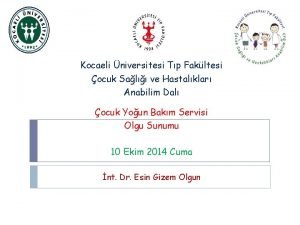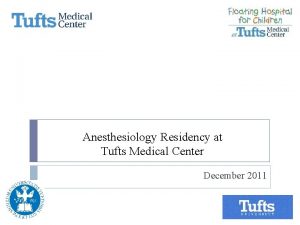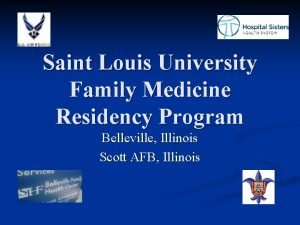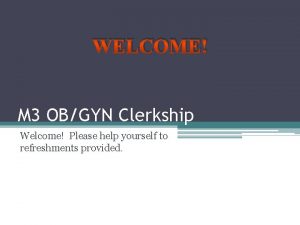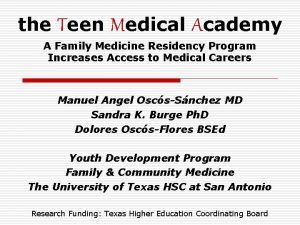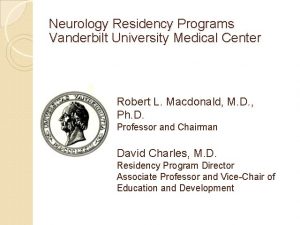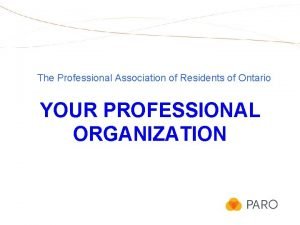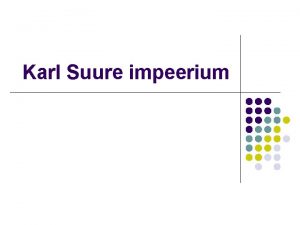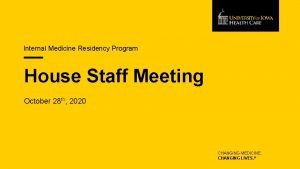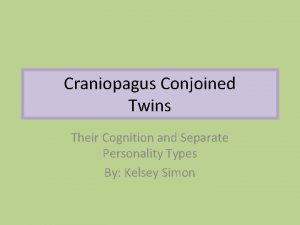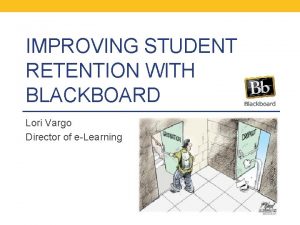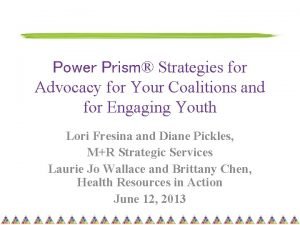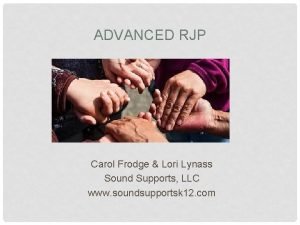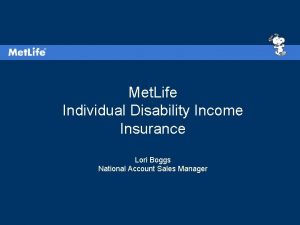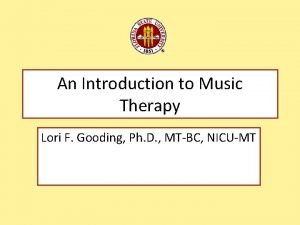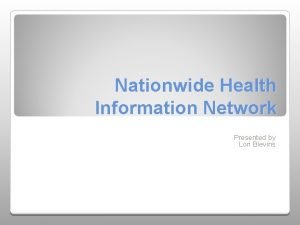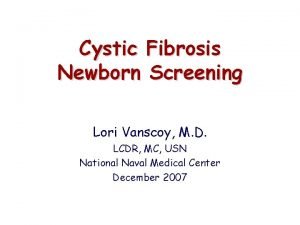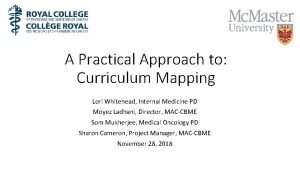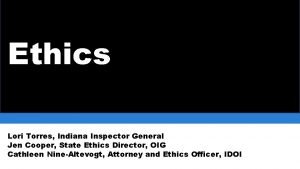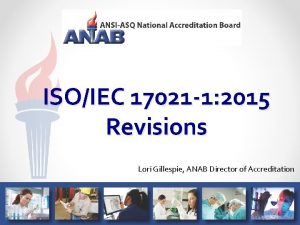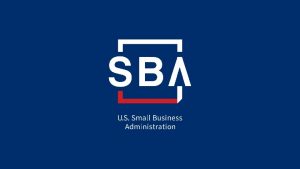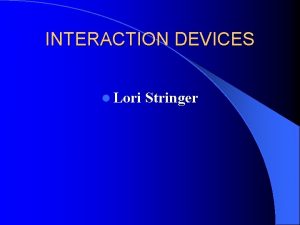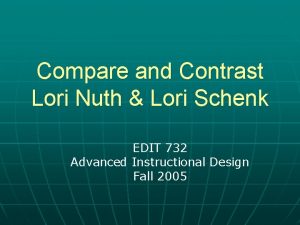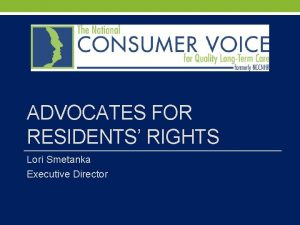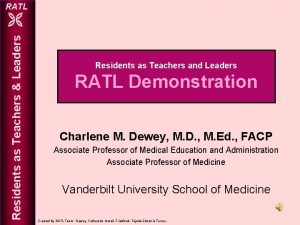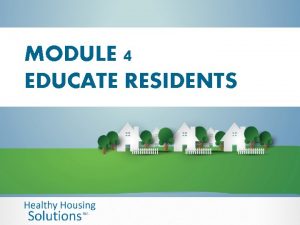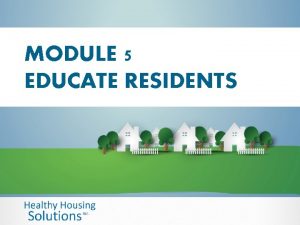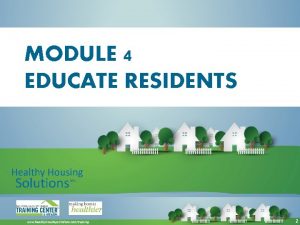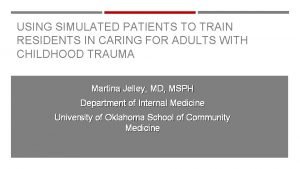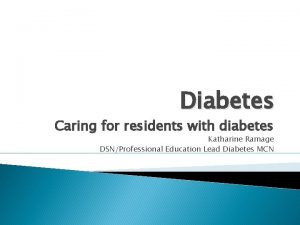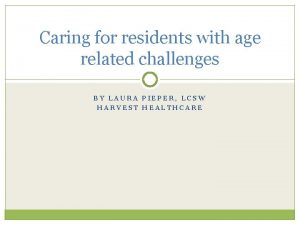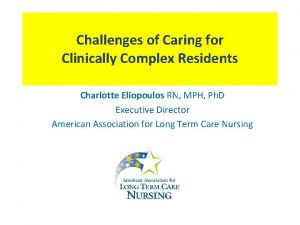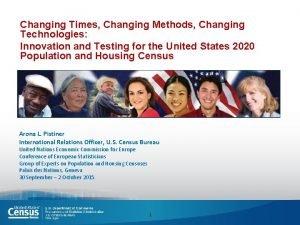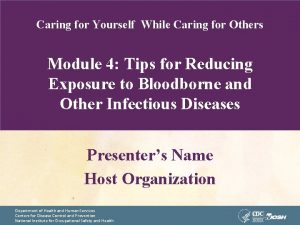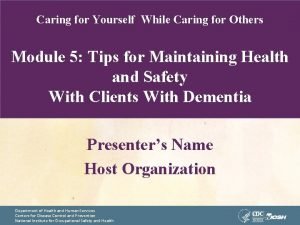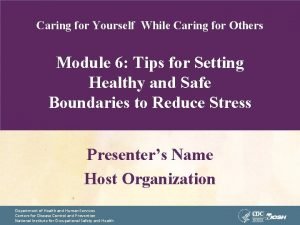Caring for Residents with Changing Needs Lori Heiner


























































- Slides: 58

Caring for Residents with Changing Needs Lori Heiner RN, MN Washington Health Care Association

Course Objectives Understand the regulatory requirements related to assessment, change of condition, taking action and evaluation of resident care. We’ll explore some of the ways a facility can fail to meet the requirements of this WAC. What could prevent failed facility practice related to WAC 388 -78 A-2120? What other associated WACs may come in conjunction with 2120? Work through scenarios to develop skills to read a Statement of Deficiency and develop a plan of correction related to care and services.

Our Feelings About LTC

Regulatory Environment

Budget Request I need one Billion-gazillion Dollars !!!

Staff Shortages

What Does the Typical AL Resident Look Like?

Principles of Person-Centered Care People have the right to determine their needs, decide how best to have those needs met, and to be provided a means to give feedback about the quality and nature of the services and supports. The more providers know about their residents, the better service they will be able to provide. Decision making involves a team where the resident is always the focus. It is not “what the person says, goes, ” but we consider and act on what people want when we plan and deliver their care. It involves informing and negotiating a care plan to suit each individual. It may require some level of compromise on behalf of the person.

Principles of Person-Centered Caregivers are attuned to strengths and interests—not simply limitations— so they can provide meaningful activities that help residents stay engaged and healthy. Caregivers take more time being with residents instead of putting the focus on care needs. This allows caregivers and residents to be equals. Puts the care in care planning and provides care in a nurturing and respectful environment.

Put the Care in Care Giving Mindset Help Emotions Conditions Support Heal

HOME &COMMUNITY BASED SERVICES RULES—WHAT IS THIS? Federal rules that cover home and community based settings that receive Medicaid funding. Apply to all community based settings, including: Assisted Living Facilities

INTENT OF THE RULE To ensure that individuals receiving long-term services have: - Their rights and individual choice protected - The opportunity to receive services in the most integrated setting appropriate - Full access to the benefits of community living and community integration

QUALITIES OF ALL HCBS Setting is integrated in and supports full access to the greater community… opportunities to engage in community life, control personal resources, receive services in the community to the same degree of access as individuals not receiving Medicaid HCBS A person-centered service plan is documented and based on individual’s needs and preferences

QUALITIES OF ALL HCBS Ensures an individual’s rights of privacy, dignity and respect, and freedom from coercion and restraint Optimizes, but does not regiment, individual initiative, autonomy, and independence in making life choices, including but not limited to daily activities, physical environment, and with whom to interact Facilitates individual choice regarding services and supports, and who provides them

Despite HCBS rules applying to Medicaid funded ALFs, all ALFs must meet rules due to the resident rights chapter that applies to ALFs in Washington State. Residents Rights Chapter RCW 70. 129

Resident Rights The assisted living facility must: Promote and protect the residents' exercise of all rights granted under chapter 70. 129 RCW Provide care and services to each resident in compliance with applicable statutes related to substitute health care decision making

ALTSA Mission Transform Lives by Promoting Choice, Independence and Safety through Innovative services Every Inspection will focus on how resident rights are being honored and PROMOTED Resident Rights start at admission and continue through to care delivery to day life to discharge/transfer

Survey Considerations with Respect to Resident Rights Right to Refuse Choice Dignity Quality of Life Communication Behaviors Timeliness Identify Resident Needs Being Met

Where Do You Begin?

WAC 388 -78 A-2120 Monitoring residents' well-being Always has been and will likely always be in the top cited WACs Why? WAC itself is broad in scope and casts a wide net for potential noncompliance Financial burdens Resident care is more complex Staffing challenges and turnover causes less continuity of care

WAC 388 -78 A-2120 Monitoring residents' well-being WAC 388 -78 A-2120 - Monitoring residents' well-being The assisted living facility must: (1) Observe each resident consistent with his or her assessed needs and negotiated service agreement; (2) Identify any changes in the resident's physical, emotional, and mental functioning that are a: (a) Departure from the resident's customary range of functioning; or (b) Recurring condition in a resident's physical, emotional, or mental functioning that has previously required intervention by others.

WAC 388 -78 A-2120 Monitoring residents' well-being (3) Evaluate, in order to determine if there is a need for further action: (a) The changes identified in the resident per subsection (2) of this section; and (b) Each resident when an accident or incident that is likely to adversely affect the resident's well-being, is observed by or reported to staff persons. (4) Take appropriate action in response to each resident's changing needs.

What Does This WAC Sound Like? Nursing Process: An organized sequence of problem-solving steps used to identify and manage the health problems of clients American Nurses Association

A Delicious PIE

Compare to Nursing Process WAC Language Nursing Process Observe Assessment Identify changes Diagnosis (nursing judgement) Evaluate need for further action Planning Take appropriate action Implementation Evaluation (still requires on-going assessment WAC 388 -78 A-2100)

WAC 388 -78 A-2120 Monitoring residents' well-being The assisted living facility must: (1) Observe each resident consistent with his or her assessed needs and negotiated service agreement;

Observation is…. Identifying patterns of behavior in care service users which may need attention Identifying problems quickly, so that they can be addressed before they worsen Spotting abuse or negligence Noticing any areas of care which could be improved

Listening Skills Exercise Janet is helping Ms. Smith put on her clothes for the day and assist her to breakfast. Ms. Smith is scheduled for an appointment later that day to go for a biopsy.

Listening Skills Exercise Janet: Just put your arm in the sleeve now and I will get you into the chair and set you up for breakfast. Ms. Smith: I am so tired. I did not sleep well and I have not had a chance to talk to my daughter in weeks. Janet: I know what you mean. I did not sleep well either last night. I had to have 2 cups of coffee before I came to work this morning. Ms. Smith: I guess I have a lot on my mind with this appointment. I don’t really know what to expect. Janet: Well, Dr. Z is really good. I wouldn’t worry about a thing with him. Did you know his wife just had twins?

Listening Skills Exercise Janet: Just put your arm in the sleeve now and I will get you into the chair and set you up for breakfast. Ms. Smith: I am so tired. I did not sleep well and I have not had a chance to talk to my daughter in weeks. Janet: Oh, you normally sleep well. Why do you think last night was different? Ms. Smith: I guess I have a lot on my mind with this appointment. I don’t really know what to expect. Janet: Oh, yes, I understand. I will have the nurse come to talk and answer questions you may have about it. I am sure you would want your daughter to know what is going on. I can help you to call her after breakfast if you would like.

Smell Caregivers need to use their sense of smell. Ability to smell diminishes as a part of aging, especially after age 70, and can put seniors at greater risk Possible causes are also sinus problems, smoking Diminished smell may be an early sign of Parkinson’s or Alzheimer's disease “Old People Smell” Nonenal develops as people age Sensitive to changes in smell to urine, feces, breath, wounds—can be a clue to a change of condition

2120 - Observe The assisted living facility must: (1) Observe each resident consistent with his or her assessed needs and negotiated service agreement; Observation occurs with every resident interaction. What do you see? What does the resident say? Does the behavior match with what they say? Is there anything different about this interaction with the resident? Is there anything different in their environment? An inability to get out of bed, refusal to eat, withdrawal from family members, anger directed at staff, fear, or request for more pain mediation. Is this assessed? Is it reflected in the care plan? Is it consistent?

WAC 388 -78 A-2120 Monitoring residents' well-being (2) Identify any changes in the resident's physical, emotional, and mental functioning that are a: Departure from the resident's customary range of functioning Recurring condition in a resident's physical, emotional, or mental functioning that has previously required intervention by others

WAC 388 -78 A-2120 Monitoring residents' well-being 3) Evaluate, in order to determine if there is a need for further action: The changes identified in the resident Each resident when an accident or incident that is likely to adversely affect the resident's well-being, is observed by or reported to staff persons Examples could include falls, burns, medication error.

WAC 388 -78 A-2120 Monitoring residents' well-being (4) Take appropriate action in response to each resident's changing needs. The appropriateness of the action will depend on the scope of practice and skill level of the person, i. e. , NAC/HCA vs LPN vs RN For a caregiver, the action may be “report to the nurse” If the facility does not have nurses then strong policies and procedures must be in place and caregivers trained on how they are to respond to resident’s changing needs.

WAC 388 -78 A-2120 Monitoring residents' well-being Actions may include: Report information to the nurse/physician Implement a care intervention Protect the resident from further harm by… Continue to monitor and re-evaluate need for further action Provide a therapeutic intervention or PRN medication Call 911

Examples Of DX That Could Require Ongoing Monitoring Seizure Disorder Constipation Respiratory Disease- SOB Cardiovascular Disease- Edema Acute Illness Chronic/ Acute Pain Infectious Disease Others?

Examples of failed practice in care and services Waiting too long before an action is taken causing distress to the resident, i. e. , pain control, delay in ABOT therapy, reporting an abnormal lab value Failure to identify a problem when the staff could have or should have known there was a change Not following up with professional recommendations to the problem, i. e. , labs ordered but not obtained, changing the texture of a diet so resident can eat, not following up with needed devices, i. e. , glasses/ hearing aids Not re-evaluating the effectiveness of an intervention Not documenting the steps in the process—you are now unable to demonstrate your efforts

The key factors that lead to non-compliance Lack of clear direction/communication to staff of what to observe Staff failed to recognize changes in condition No communication regarding resident changes of condition No action on reported changes Action not timely No evaluation of observed/identified/reported changes

The key factors that lead to non-compliance No documentation of facility’s observation, identification, evaluation, or action taken Poor/Breakdown in communication channels Inadequate staffing

What can prevent failed practice related to 2120? Thorough assessment and care planning Clear direction, interventions, and communication to caregivers regarding each resident’s assessed needs Clear lines of communication and responsibility related to changes in resident condition Timely and thorough follow-up to identified changes of condition Systemic review of records/audits Staff education regarding conditions effecting residents and their assessed needs Thorough and complete documentation

What can prevent failed practice related to 2120? Systems that inform and involve direct care staff and nursing services of residents’ assessed needs Training for staff to know how to recognize change Know your residents

Facility responsibilities to prevent noncompliance Audits-checks & balances Adequate staffing Training Evaluation of staff skills/abilities Operational QA systems

Facility responsibilities to prevent noncompliance Documentation Use of established policies/procedures and tools, whether internal, corporate, or tools such as: INTERACT Program Stop and Watch SBAR Care/Decision Pathways

What other WACs may be cited or could be associated with 2120? Assessment, On-Going Assessments Negotiated Service Agreement contents Implementation of Negotiated Service Agreement Medication System Failure to notify MD and family of changes Content of Resident Records

WAC 388 -78 A-2100 On-going assessments The assisted living facility must: Complete an assessment specifically focused on a resident's identified problems and related issues: Consistent with the resident's change of condition as specified in WAC 38878 A-2120; When the resident's negotiated service agreement no longer addresses the resident's current needs and preferences; When the resident has an injury requiring the intervention of a practitioner. Ensure the staff person performing the on-going assessments is qualified to perform them.

WAC 388 -78 A-2140 Negotiated service agreement contents The assisted living facility must develop, and document in the resident's record, the agreed upon plan to address and support each resident's assessed capabilities, needs and preferences, including the following: (1) The care and services necessary to meet the resident's needs, including: (a) The plan to monitor the resident and address interventions for current risks to the resident's health and safety that were identified in one or more of the following: (i) The resident's preadmission assessment; (ii) The resident's full assessments; (iii) On-going assessments of the resident;

On-Going Assessment/Negotiated Service Plan Both the patient’s status and the effectiveness of the action (or inaction) must be continuously evaluated, and the care plan modified as needed. The observed resident’s needs must match the resident’s assessment must match the resident’s care plan must match the services the resident is receiving, must match what the caregivers say they do for the resident.

WAC 388 -78 A-2410 Content of Resident Records The assisted living must organize and maintain resident records in a format the assisted living facility determines to be useful and functional to enable the effective provision of care and services to each resident. Active resident records must include the following: Documentation consistent with WAC 388 -78 A-2120 Monitoring resident well-being.

Keys to Success Staff must know the residents enough to recognize a change Staff must be trained to know how to respond to a change- includes subtle changes, obvious changes and emergent changes What process do you use to ensure that the first two are in place?

Communication- You need a process and you must evaluate it What are your processes you use to communicate necessary information about resident care? Do these processes ensure that all departments that need to know are receiving the communication? How do you ensure all staff are trained to know these processes? Have you had a situation when information was not communicated to all that needed it or was not timely? What was your response when that happened?

Need to develop systems for your facility INTERACT Program-clinical practice tools, strategies to implement them, and related educational resources The use of INTERACT Tools provide staff guidelines for assessment and intervention to identify changes in condition sooner Tools allow for clear, comprehensive communication and coordination across settings

Stop and Watch Early Warning Tool Purpose is to: Identify and document changes in residents Communicate changes to other nursing staff Identify possible opportunities to prevent a hospital transfer Improve over all level of care

Stop and Watch Early Warning Tool https: //interact 2. net/assisted_living/ALF%20 Tools%20 July%202014/INTERACT%2 0 ALF%20 Communication%20 Tools/INTERACT%20 ALF%20 Communication%20 w ithin%20 Facility/Assisted%20 Living%20 Stop%20 and%20 Watch%20 Early%20 War ning%20 Tool%207 -17 -2014. pdf

SBAR Communication Tool Used by Licensed Nursing staff to evaluate and communicate acute changes in condition to MD, NP, and/or PA Also, separate form for caregivers Documentation tool for both the evaluation and the communication

SBAR Communication Form and Progress Note for Licensed Nurses in Assisted Living https: //interact 2. net/assisted_living/ALF%20 Tools%20 July%202014/INTERACT%2 0 ALF%20 Communication%20 Tools/INTERACT%20 ALF%20 Communication%20 w ithin%20 Facility/SBAR_Change_In_Condition_AL%20(10). pdf

SBAR Communication Form & Progress Note for Caregivers in Assisted Living https: //interact 2. net/assisted_living/ALF%20 Tools%20 July%202014/INTERACT%2 0 ALF%20 Communication%20 Tools/INTERACT%20 ALF%20 Communication%20 w ithin%20 Facility/Assisted%20 Living%20 Stop%20 and%20 Watch%20 Early%20 War ning%20 Tool%207 -17 -2014. pdf

Our Contact Information Elena Madrid, RN, BSN Director of Regulatory Affairs T|800 -562 -6170, ext. 105 P|360 -352 -3304, ext. 105 F|360 -754 -2412 elenamadrid@whca. org Lori Heiner, RN, MN Assisted Living Program Specialist T|800 -562 -6170, ext. 107 P|360 -352 -3304, ext. 107 F|360 -754 -2412 loriheiner@whca. org
 Dr. jean watson
Dr. jean watson Ina petri
Ina petri Polarity analysis
Polarity analysis Heiner frei
Heiner frei Heiner sendromu
Heiner sendromu Heiner frei polaritätsanalyse
Heiner frei polaritätsanalyse Simple claustral complex
Simple claustral complex Strategic gender needs and practical gender needs
Strategic gender needs and practical gender needs Primary needs and secondary needs
Primary needs and secondary needs Learning needs definition
Learning needs definition Primary needs and secondary needs
Primary needs and secondary needs Michael levitt uw
Michael levitt uw Tourism involving non-residents of the given area.
Tourism involving non-residents of the given area. Lahey clinic anesthesiology residency
Lahey clinic anesthesiology residency Slu ent residents
Slu ent residents Unm internal medicine residents
Unm internal medicine residents Umass memorial nurse residency program
Umass memorial nurse residency program Nutrition and hydration chapter 15
Nutrition and hydration chapter 15 Unmc obgyn residents
Unmc obgyn residents Uf neurology residency
Uf neurology residency Uthscsa internal medicine residents
Uthscsa internal medicine residents Vanderbilt nurse residency interview questions
Vanderbilt nurse residency interview questions Explain personal care of residents
Explain personal care of residents Dr. julia creider
Dr. julia creider Karl suure tähtsaim residents
Karl suure tähtsaim residents Uihc internal medicine residency
Uihc internal medicine residency Https://ncc-efm.org/game/efmgame.cfm
Https://ncc-efm.org/game/efmgame.cfm Famous yonkers residents
Famous yonkers residents Informed delivery multiple residents
Informed delivery multiple residents Krista tatiana
Krista tatiana Elex searching for clues
Elex searching for clues Lori vargo
Lori vargo Lori cabrera
Lori cabrera Maximo everyplace
Maximo everyplace Lori stromness
Lori stromness Lori fresina
Lori fresina Jody lori
Jody lori Lori marsh
Lori marsh Organigramme alstom le creusot
Organigramme alstom le creusot Lori lynass
Lori lynass Michael cormac roth
Michael cormac roth Lori raetzman
Lori raetzman Lori bounded
Lori bounded Met life
Met life Fsu nicu mt
Fsu nicu mt Lori blevins
Lori blevins Lori vanscoy
Lori vanscoy Lori simon-rusinowitz
Lori simon-rusinowitz Curriculum mapping template
Curriculum mapping template Lori torres indiana
Lori torres indiana Lori gillespie
Lori gillespie Lori gillen sba
Lori gillen sba Lori hanson dnr
Lori hanson dnr Lori leiter
Lori leiter Ladislo biro
Ladislo biro Lori kempe
Lori kempe Danielle lori doci
Danielle lori doci Lori carl
Lori carl Lori k grimes hill afb
Lori k grimes hill afb




